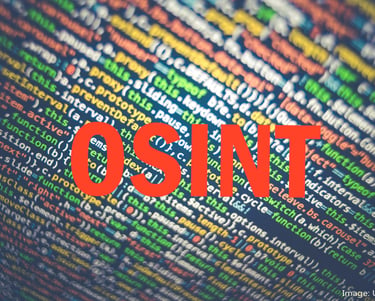Evolution of Open Source Intelligence (OSINT)


The genesis of OSINT[1], as we know it, in the United States goes back to the 1940s and World War II when the Office of Strategic Services (OSS) dedicated a division to researching and analyzing available printed news and articles, broadcasted programs on radio, and any other public information from enemies. The division was called the “Research and Analysis Branch” (Colquhoun, 2016).
The principle of gathering useful information from public media gradually became an acceptable part of most government agencies after the war. Utilizing OSINT in many organizations was growing, but horizontal and old fashion librarian style. The popularity of computers, the internet, and the World Wide Web in the human lifestyle offered new possibilities and deeper dive into the world of intelligence (Glassman-Kang, 2012) and not only the information gathering improved, but also processing, analyzing, and producing intelligence reports was raised to another level.
Employing new technologies and improving the methods and processes led to the creation of new organizational entities and the development of frameworks, guidelines, and several handbooks in the US government as well as its allies in NATO (Schauer- Störger, 2013).
The foundation of OSINT in the modern era requires utilizing a complex range of software and Services because of the massive amount of available data. The public sector, with a limited budget and excessive bureaucracy, needed private sector intervention to invest, invent, and efficiently produce actionable OSINT for the government, as per their request. The nature of public availability of the Information used in the OSINT framework makes this cooperation easier to achieve with a better rate of efficiency.
Information is power, and often the private sector itself has become a big consumer of the OSINT in order to conduct business effectively in the global market, and as a result, OSINT has been revolutionized over the past decade (Williams-Blum, 2018). The increasing rate of cybercrimes, cyber espionage, and cyber terrorism has given a clearer vision to the senior executive levels and aided them in realizing the value of OSINT in supporting organizational security by identifying the threats and enabling them to do a more effective risk assessment and response in any incident (Flashpoint, 2022). Threats like unintentional data exposure, physical and virtual vulnerabilities, critical updates or patches, and serious errors in systems could be realized and remediated in a timely manner (Lifars, 2021) and before turning into costly incidents.
Leveraging OSINT in the public sector provides an imperative tool for both intelligence and counterintelligence at the national level or with a criminal investigation by local law enforcement. The private sector can benefit from the same privilege in corporate security and competitive intelligence in the modern business environment.
The concept of leveraging access to the massive pile of data in the rise of social media, which essentially has created a new digital lifestyle in our living societies, and turning the data into actionable intelligence has created such an effective edge for the decision-makers, public or private that I am inclined to predict it is conceivable to turn OSINT into a new industry in the private sector and/or new agency in the public divisions (Johnson, 2022) in the coming decade.
The importance of OSINT as described and its popularity would not, even remotely, suggest that OSINT has not been facing challenges. Data security laws and restrictions, content filtration, data rejections, and geopolitical challenges (Bruce, 2019) are just some of the challenges to overcome. However, it seems that the future of OSINT is bright and progress in this field is inevitable.
------------------------------------------------
[1] The term “OSINT” was first coined by the US military in the late 1980s
References:
Johnston, Kevin. 2022. “It’s Time to Give OSINT Its Own Agency.” Fair Observer. February 25, 2022. https://www.fairobserver.com/region/north_america/kevin-johnston-osint-us-intelligence-community-internatinoal-security-news-35271/.
Colquhoun, Cameron. 2016. “A Brief History of Open Source Intelligence.” Bellingcat. July 14, 2016. https://www.bellingcat.com/resources/articles/2016/07/14/a-brief-history-of-open-source-intelligence/.
Williams, Heather J., and Ilana Blum. 2018. Defining Second Generation Open Source Intelligence (Osint) for the Defense Enterprise. Santa Monica, CA: RAND.
Glassman, Michael, and Min Ju Kang. 2012. “Intelligence in the Internet Age: The Emergence and Evolution of Open Source Intelligence (OSINT).” Computers in Human Behavior 28, no. 2: 673–82. https://doi.org/10.1016/j.chb.2011.11.014.
Schaurer, Florian, and Jan Störger. n.d. “The Evolution of Open Source Intelligence (OSINT).” Afio.com. Accessed November 22, 2022. https://www.afio.com/publications/Schauer_Storger_Evo_of_OSINT_WINTERSPRING2013.pdf.
“What Is Open Source Intelligence: The Importance of OSINT in Your Organization’s Threat Landscape.” 2022. Flashpoint. August 2, 2022. https://flashpoint.io/blog/what-is-osint-open-source-intelligence/.
Llc, Lifars, and LIFARS. 2021. “What Is Open-Source Intelligence and Why Is It Important?” LIFARS, a SecurityScorecard Company. LIFARS is the global leader in Digital Forensics, Ransomware mitigation and Cyber Resiliency Services. January 18, 2021. https://www.lifars.com/2021/01/what-is-open-source-intelligence-and-why-is-it-important/.
Bruce, Debra. 2019. “Top 5 OSINT Challenges Organizations Need to Overcome.” Knowledgenile. September 18, 2019. https://www.knowledgenile.com/blogs/osint-challenges/.

